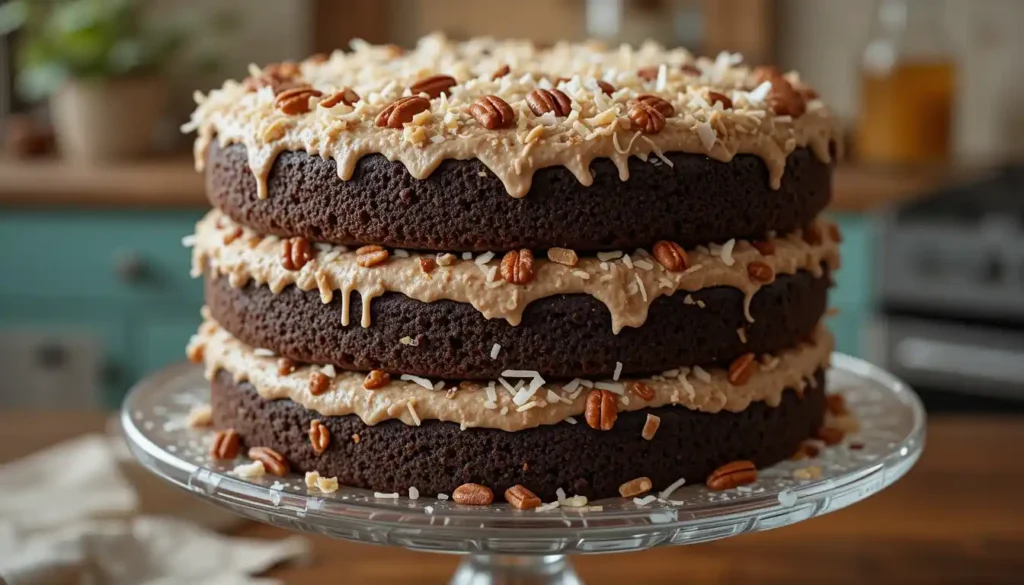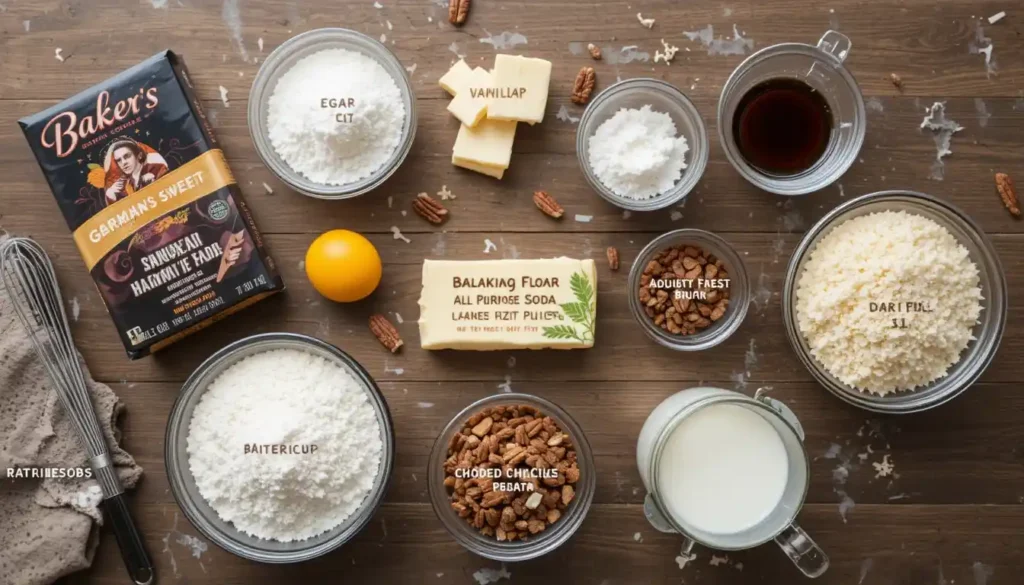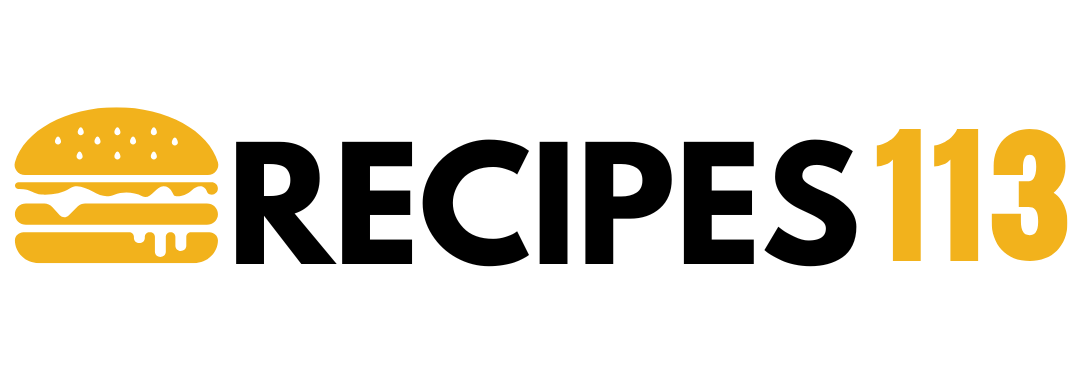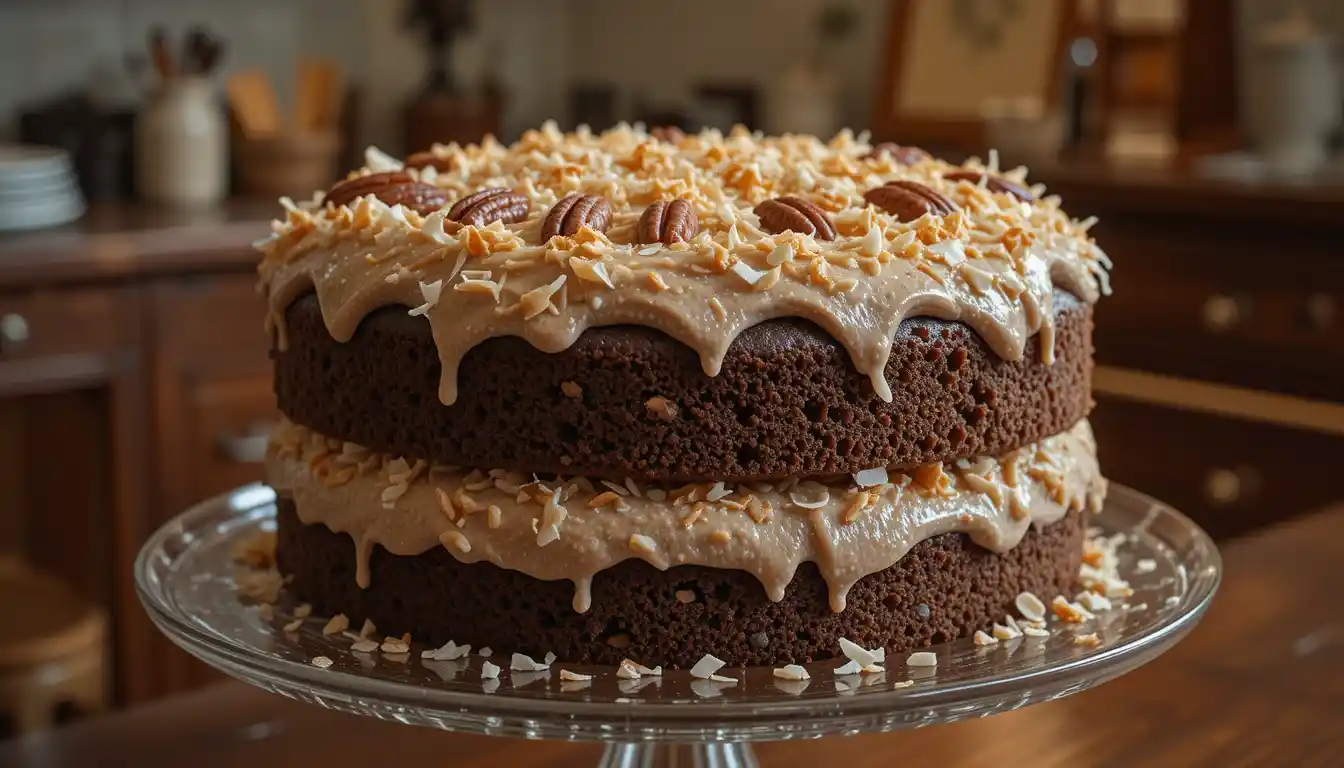Table of Contents
“A party without cake is just a meeting.” – Julia Child’s iconic words remind us how desserts transform ordinary moments into celebrations. Today, we explore a treat steeped in tradition: a decadent layered creation that’s captivated generations with its rich textures and nostalgic charm.
Born from European baking traditions, this dessert blends velvety cocoa layers with a signature caramel-coconut topping. Its origins trace back to 19th-century methods, where bakers perfected the balance between moist crumb and luscious fillings. One family story tells of an 86-year-old artisan who still prepares it for milestone birthdays, proving its enduring appeal.
What makes this recipe special? It’s the careful pairing of premium chocolate with airy egg-white folds, creating a lightness that contrasts beautifully with the indulgent frosting. Whether you’re a first-time baker or a seasoned pro, we’ll walk through every step – from selecting ingredients to achieving that picture-perfect finish.

Introduction to This Decadent Cake
What transforms simple ingredients into a legendary dessert? Tradition and care. This layered masterpiece balances nostalgic flavors with technical precision, creating a treat that feels both familiar and extraordinary.
What Makes This Dessert Stand Out?
The magic lies in contrasts. Airy layers made with baking soda rise perfectly at oven 350°F, while egg whites whipped to stiff peaks add cloud-like lightness. Between these cocoa-kissed tiers rests a caramelized frosting studded with toasted pecans and coconut—a nod to old-world confectionery artistry.
Stories Baked Into Every Slice
One baker recalls her grandmother’s handwritten notes: “Always double-boil the frosting—patience makes it silkier.” Another shares how this dessert became their family’s graduation tradition after a cousin requested it instead of gifts. Its rich history mirrors shared moments—holiday tables, anniversaries, or quiet Sunday suppers where laughter lingers like the scent of melted chocolate.
Modern twists haven’t overshadowed its roots. While some now use maple syrup instead of granulated sugar, the core remains unchanged. As one enthusiast puts it: “You taste the love in every bite.”
baker’s german chocolate cake recipe: A Timeless Classic
Behind every iconic dessert lies a story of innovation. This beloved layered treat traces its roots to 19th-century home kitchens, where resourceful cooks combined European techniques with locally available ingredients. “We didn’t have fancy tools—just wooden spoons and elbow grease,” notes a handwritten journal from 1882, showcasing the hands-on approach that shaped its legacy.

Origin and Unique Ingredients
Central to its flavor profile is a specific sweet chocolate developed in 1852, prized for its smooth melt and balanced bitterness. Unlike modern shortcuts, traditional versions separate egg yolks and whites—the yolks enrich the batter, while whipped whites create lift. A vintage recipe card advises: “Beat the sugar and butter for 8 minutes—no less—until pale as morning light.”
| Ingredient | Role | Impact |
|---|---|---|
| Sweet Chocolate | Base flavor | Deep, rounded cocoa notes |
| Egg Whites | Structure | Airy crumb texture |
| Cane Sugar | Caramelization | Crisp crust formation |
| Toasted Coconut | Frosting texture | Crunchy-sweet contrast |
Why This Recipe Continues to Delight
The magic lies in contrasts: dense yet tender layers meet a frosting that’s both silky and nutty. Modern bakers appreciate its adaptability—substitute honey for sugar, or swap pecans for almonds. One food blogger raves: “It’s like tasting history, but better—because you made it yourself!”
Timing proves crucial. Overmix the batter, and you’ll lose lightness; undermix, and the sugar won’t dissolve. That’s why the original instructions specify 6-7 minutes of precise folding—a rhythm perfected through generations of trial and error.
Essential Ingredients and Their Roles
Quality ingredients are the foundation of any iconic recipe, each playing a crucial part. Whether you’re measuring by the cup or whipping egg whites, precision transforms simple components into something extraordinary.
Key Components from Chocolate to Coconut
Real butter adds richness that substitutes can’t match. One baker notes: “Margarine makes it greasy—always use the good stuff!” Pure vanilla enhances flavor depth, while sifted flour prevents clumps for a tender crumb.
| Ingredient | Function | Pro Tip |
|---|---|---|
| All-Purpose Flour | Structure | Sift twice for airiness |
| Egg Whites | Volume | Whip to glossy peaks |
| Unsalted Butter | Moisture | Softened, not melted |
| Vanilla Extract | Flavor Boost | Use pure, not imitation |
| Parchment Paper | Pan Prep | Grease & dust pans |
Ingredient Substitutions and Variations
No buttermilk? Mix 1 cup milk with 1 tbsp lemon juice. For nut allergies, sunflower seeds replace pecans. Gluten-free? Swap flour 1:1 with almond flour blend.
When preparing pans, cocoa powder works better than flour for dusting—it avoids white streaks. Vegan bakers love flax eggs here: 1 tbsp ground flax + 3 tbsp water per egg white.
Step-by-Step Baking Instructions
The secret to a flawless bake lies in mastering the fundamentals. Let’s break down each phase, from measuring ingredients to pulling golden layers from the oven. Precision here ensures your creation rises evenly and tastes sublime.

Preparing and Measuring Ingredients
Start by separating yolks from whites—use cold eggs for cleaner division. Measure cups of flour by spooning it into the cup, then leveling with a knife. For buttermilk, pour it into liquid measuring cups at eye level. One baker advises: “Mismeasuring leavening agents? That’s how sunken middles happen.”
Mixing Techniques and Batter Tips
Whisk dry ingredients first to distribute baking soda evenly. Cream butter and sugar until fluffy—about 3 minutes. Alternate adding buttermilk and dry mix to prevent curdling. Fold whipped egg whites into the batter using a spatula: “Think gentle hugs, not rough shakes.”
Oven Settings and Baking Time
Preheat to 350°F—an oven thermometer ensures accuracy. Pour batter into greased pans, smoothing tops with a knife. Bake 28-32 minutes. Test doneness by pressing the center lightly—it should spring back. Cool in pans 10 minutes before transferring to racks.
| Step | Key Action | Pro Tip |
|---|---|---|
| Yolk Separation | Use chilled eggs | Save yolks for custards |
| Buttermilk Prep | Room temperature | Stir before measuring |
| Baking | Middle oven rack | Rotate pans halfway |
Perfecting Your Decadent Chocolate Frosting
A dessert’s crowning glory lies in its finishing touches. For this iconic treat, the frosting isn’t an afterthought—it’s where science meets sweetness. Balancing silkiness with structure requires careful attention to timing and technique.
Cooking, Thickening, and Flavoring the Frosting
Begin by combining milk, sugar, and egg yolks in a heavy saucepan. Stir continuously over medium heat for 12 minutes—this prevents scorching while activating thickening agents. “The mixture should coat your spoon like liquid satin,” advises a pastry chef with three decades of experience.
Remove from heat and whisk in butter, vanilla, and a pinch of salt. For stability, add ¼ tsp baking soda—it reacts with acidic components, creating tiny air pockets. Let cool until spreadable, about 45 minutes.
| Stage | Key Action | Visual Cue |
|---|---|---|
| Cooking | Constant stirring | Pale golden hue |
| Thickening | Thermometer check | 170°F internal temp |
| Flavoring | Butter incorporation | Glossy sheen |
Incorporating Coconut and Pecans for Texture
Toast 1 cup shredded coconut and ½ cup chopped pecans separately. Fold them into the cooled frosting—this adds crunch without sinking. For extra hold, chill the mixture 15 minutes before spreading.
If coating the entire dessert, increase water by 1 tbsp during cooking. This adjusts consistency for smoother edges. Store leftovers between parchment paper sheets to prevent drying—simply peel and reuse when needed.
Tips and Tricks for a Moist, Flavorful Cake
Ever wonder why some desserts stay fresh for days while others dry out overnight? The answer lies in technique. Mastering a few simple methods ensures your creation remains tender and moist from the first slice to the last.
Whipping Egg Whites Like a Pro
Room-temperature eggs whip faster and hold air better. Separate yolks while cold, then let whites sit 20 minutes. Use a spotlessly clean bowl—any grease prevents stiff peaks. One baker shares: “Add ¼ tsp cream of tartar per 3 whites—it stabilizes the mixture like magic!”
- Beat at medium speed until foamy
- Gradually increase to high until glossy
- Test peaks by lifting whisk—tips should stand straight
Pan Prep & Cooling Secrets
Line pans with parchment circles cut to size. Dust sides with cocoa powder instead of flour—it prevents white streaks on dark layers. After baking, let pans cool 10 minutes on racks. This allows structure to set without trapping steam.
| Step | Tool | Purpose |
|---|---|---|
| Greasing | Pastry brush | Even coverage |
| Testing | Toothpick | Check for moist crumbs |
| Storage | Air-tight container | Preserve texture |
For extra moisture, brush warm layers with simple syrup (1:1 milk and sugar). Let cool completely before frosting—rushing this step causes sliding. As one recipe developer notes: “Patience isn’t just a virtue here—it’s the secret ingredient.”
Variations and Adaptations for Home Bakers
Every kitchen has its personality, and your tools should amplify creativity—not limit it. While staying true to the dessert’s soul, smart tweaks let you tailor this layered masterpiece to your equipment and taste buds. Let’s explore how to make it shine in any setting.
Customizing the Recipe for Different Bakeware
Switching pan sizes? No problem. For a 9×13-inch sheet, reduce baking time by 8–10 minutes and check the center with a toothpick. Round pans need even batter distribution—use a kitchen scale to divide portions precisely. One reviewer notes: “I bake cupcakes using the same chocolate cake recipe—just fill liners halfway and watch the oven!”
Maintain airiness by whipping egg whites until stiff peaks form. This step remains crucial, whether you’re using mini loaf pans or a Bundt mold. For crisp edges, grease pans with butter and dust with cocoa powder instead of flour.
Adjusting Frosting Sweetness to Taste
Prefer less sugary toppings? Cut the german sweet chocolate by 25% and add a pinch of sea salt. Or swap half the sugar with honey for floral notes. A pastry chef suggests: “Fold in Greek yogurt for tang—it balances richness without compromising texture.”
When modifying the chocolate cake recipe, keep the egg whites at room temperature. They’ll whip faster, ensuring those stiff peaks form even if you tweak other elements. Remember—the center should always feel springy, never dense.
Conclusion
Some creations become timeless not through complexity, but by mastering balance. This dessert’s legacy thrives through its thoughtful harmony of sweet chocolate richness and airy cake layers—a testament to generations of bakers refining their craft.
From carefully whipped egg yolks to evenly heated cake pans, each step honors tradition while inviting personal flair. The toasted coconut topping adds rustic charm, contrasting beautifully with velvety textures. Whether following measurements to the gram or adding a dash of cinnamon, your version becomes part of its evolving story.
Share your twists with fellow enthusiasts—maybe a dash of espresso in the batter or a salted caramel drizzle. Every adaptation keeps this treat alive in modern kitchens. After all, great recipes aren’t just followed; they’re lived in, laughed over, and passed down.
Now it’s your turn. Preheat that oven, and let the aroma of melted sweet chocolate fill your home. Here’s to creating new memories—one perfect slice at a time.
FAQ
Can I substitute buttermilk in this recipe?
Yes! Mix 1 tablespoon of white vinegar or lemon juice with 1 cup of milk. Let it sit for 5 minutes to mimic the tang and texture of buttermilk.
How do I prevent the layers from drying out?
Use room-temperature ingredients, avoid overmixing the batter, and check doneness with a toothpick at 30 minutes. Let layers cool completely before frosting to lock in moisture.
Why do the egg whites need to form stiff peaks?
Whipping egg whites to stiff peaks adds air, creating a lighter crumb. Ensure your bowl and beaters are grease-free, and fold them gently into the batter to maintain volume.
Can I reduce the sweetness of the frosting?
Absolutely. Cut the sugar by ¼ cup or add a pinch of salt to balance the sweetness. Toasted pecans also add a savory contrast to the coconut mixture.
What’s the best way to prep cake pans?
Grease pans with butter, line the bottoms with parchment paper, and dust with flour. This prevents sticking and ensures clean release after baking.
Is this dessert actually from Germany?
Despite the name, it’s an American creation! The recipe originated with a Texas homemaker using Baker’s German’s Sweet Chocolate, named after Samuel German, an English-American confectioner.


1 thought on “baker’s german chocolate cake recipe”
Comments are closed.